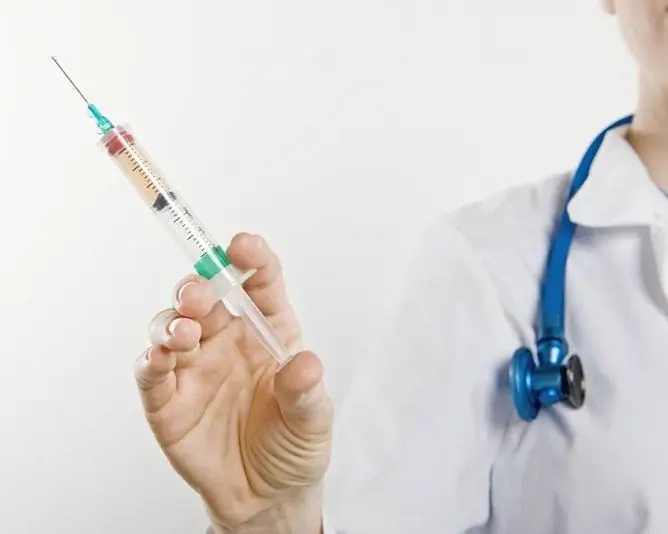- Author Rachel Wainwright [email protected].
- Public 2023-12-15 07:39.
- Last modified 2025-11-02 20:14.
Glutoxim
Glutoxim: instructions for use and reviews
- 1. Release form and composition
- 2. Pharmacological properties
- 3. Indications for use
- 4. Contraindications
- 5. Method of application and dosage
- 6. Side effects
- 7. Overdose
- 8. Special instructions
- 9. Application during pregnancy and lactation
- 10. Drug interactions
- 11. Analogs
- 12. Terms and conditions of storage
- 13. Terms of dispensing from pharmacies
- 14. Reviews
- 15. Price in pharmacies
Latin name: Glutoxim
ATX code: L03AX
Active ingredient: glutamyl-cysteinyl-glycine disodium (Glutamyl-cysteinyl-glycine disodium)
Manufacturer: PHARMA VAM (Russia); Russian Cardiology Research and Production Complex, Ministry of Health of the Russian Federation - Experimental production of biomedical products (Russia); Federal State Unitary Enterprise Federal State Unitary Enterprise (Russia); Kombiotech NPK (Russia)
Description and photo update: 2019-20-08
Prices in pharmacies: from 784 rubles.
Buy

Glutoxim is an immunostimulating drug involved in the regulation of metabolic processes in tissues and cells.
Release form and composition
Glutoxim is produced in the form of a solution for injection: a transparent, weakly colored or colorless liquid with a weak vinegar odor or practically odorless (in 1 or 2 ml ampoules made of neutral glass, 5 or 10 ampoules in a blister strip, 1, 2, 5 or 10 packs in a cardboard box complete with a scarifier or ampoule knife; packs of ampoules with notches, points and break rings are not supplied with scarifiers or ampoule knives).
The composition of 1 ml of injection solution includes:
- Active ingredient: Glutamyl-Cysteinyl-Glycine disodium - 5, 10 or 30 mg;
- Auxiliary components: diluted acetic acid, sodium acetate, water for injection.
Pharmacological properties
Pharmacodynamics
Glutoxim has an immunomodulatory, hepatoprotective, detoxifying, hemostimulating effect.
The main effects of the drug:
- suppression of drug resistance of tumor cells to anthracycline antibiotics, alkylating agents;
- potentiation of the effect of doxorubicin on tumor cells, as well as drugs used in chemotherapy (including isoniazid, rifampicin, rifabutin, cycloserine, capreomycin, levofloxacin, cationic antimicrobial peptide catalecidin) on Mycobacterium tuberculosis (Koch's bacillus);
- contributing to overcoming the drug resistance of Mycobacterium tuberculosis to isoniazid, associated with the inhA (enol-ACP reductase gene) and katG (catalase-peroxidase gene) genes.
The mechanism of the immunomodulatory action of Glutoxim is due to the receptor-mediated effect on calcium-dependent signaling pathways of macrophages. As a result of therapy, the following indicators increase:
- survival and functional capacity of tissue macrophages;
- exocytosis of submembrane granules with intracellularly parasitic forms of Mycobacterium tuberculosis;
- the formation of reactive oxygen species;
- activity of lysosomal enzymes;
- secretion of cytokines (including interleukins 1, 2 and 6, tumor necrosis factor, erythropoietin, interferons) and cationic antimicrobial peptides (including defensins and cathelicidins);
- absorption and death of microorganisms.
The hemostimulating properties of Glutoxim are due to a receptor-mediated increase in bone marrow hematopoiesis, including the processes of erythro-, lymphopoiesis and granulocyto-monocytopoiesis. The effect on precursor cells of different lines of blood corpuscles is associated with the functioning of the MAP and inositol kinase systems, which increases the resistance of differentiating hematopoietic cells and restores their sensitivity to the influence of endogenous hematopoietic factors.
The mechanism of hepatoprotective and detoxifying action of Glutoxim is based on the enhancement of the expression of enzymes of the second phase of detoxification of xenobiotics, including glucose-6-heme oxygenase-1, phosphate dehydrogenase, glutathione peroxidase, glutathione reductase, glutathione level and also on growth of glutathione, which provides protection of cellular structures from the toxic effects of radicals.
The use of Glutoxim affects the activity of the multidrug resistance factor of tumor cells - the protein P-glycoprotein (Pgp), which determines resistance to chemotherapy (including drugs of alkylating action and anthracycline antibiotics).
During therapy with Glutoxim, the reaction of transformation of isoniazid (prodrug) into its pharmacologically active form - isonicotinic acid is initiated, which has a bacteriostatic effect on Mycobacterium tuberculosis. Thanks to this, the drug resistance of Koch's bacillus, caused by the negative transformation of the inhA and katG genes, is overcome.
Glutoxim leads to increased secretion of cationic peptides (catalecidins and defensins) by macrophages, stimulates their absorption by mycobacterium tuberculosis, which determines an indirect antibacterial effect.
As a result of stimulating the processes of exocytosis of vesicles from macrophages with intracellular parasitic microorganisms, including Koch's bacillus, their removal from the pharmacological shelter is ensured. Thanks to this, they become available for the action of antibacterial drugs - rifampicin, rifabutin, isoniazid, cycloserine, levofloxacin, capreomycin.
Pharmacokinetics
Glutamyl-cysteinyl-glycine disodium is a natural metabolite. This determines the characteristics of the metabolism of a substance by existing cellular enzymatic systems.
Bioavailability after intramuscular, intravenous or subcutaneous administration exceeds 90%. The relationship between dose and plasma concentration in blood is linear. The time to reach C max (maximum concentration) depends on the route of administration, the value is 2-5 or 7-10 minutes after intravenous and intramuscular administration, respectively.
The substance is metabolized in tissues and organs (as a natural product of a peptide nature). It is excreted in the urine.
Indications for use
According to the instructions, Glutoxim is recommended for use as a means of prevention and therapy of secondary immunodeficiency conditions associated with radiation, chemical and infectious factors, to restore suppressed immune reactions and reduce the depressed state of bone marrow hematopoiesis. The drug is also used to increase the body's resistance to various pathological effects of physical and / or chemical factors, infectious agents (radiation, intoxication, etc.).
Glutoxim injections are indicated in the following cases:
- Chronic viral hepatitis B and C (as a hepatoprotector);
- Chronic obstructive pulmonary disease (to enhance the therapeutic effect of antibacterial agents);
- Postoperative period (to prevent purulent complications);
- Malignant neoplasms (as part of complex therapy);
- Oncology (for the treatment and prevention of toxic responses from radiation and chemotherapy, in order to reduce hepato- and hemotoxic effects, and to promote effective restoration of bone marrow hematopoiesis during antitumor therapy);
- Severe common forms of tuberculosis of all localizations (as part of complex therapy, in the presence of drug resistance of mycobacterium tuberculosis);
- Chronic hepatitis in tuberculosis patients against the background of anti-tuberculosis treatment (in order to prevent exacerbations);
- Anti-tuberculosis therapy (for the treatment of toxic complications);
- Psoriasis, including moderate and severe forms with arthropathy, erythroderma (as part of complex therapy);
- Diseases of various origins (to eliminate or smooth out the manifestations of a nonspecific disease syndrome: increased pain sensitivity, fatigue, anemia, loss of appetite).
Contraindications
The use of Glutoxim is contraindicated in case of individual hypersensitivity to its components.
It is not recommended to use the drug during pregnancy and lactation (breastfeeding), since no clinical studies have been conducted on the safety of its use during these periods.
Instructions for the use of Glutoxim: method and dosage
Glutoxim solution is administered intravenously (i / v), intramuscularly (i / m) and subcutaneously (s / c).
Recommended dosage regimen: 5-40 mg daily (course - 50-300 mg), depending on the nature of the disease / condition, namely:
- Prophylaxis - 5-10 mg i / m daily for 2 weeks;
- Tuberculosis (as part of complex therapy) - i / m daily 1 time per day, 60 mg for the first 10 days, the next 20 days - i / m every other day, that is, one injection of 60 mg every 2 days (if necessary, after 1 -6 months repeat course);
- Psoriasis (as part of complex therapy) - i / m daily at a daily dose of 10 mg for 15 days, then another 5 weeks at 10 mg 2 times a week; full course of therapy - 25 injections;
- Chemotherapy in oncology (as a means of accompaniment) - s / c, 60 mg 1.5-2 hours before using anticancer drugs; then between courses of chemotherapy, the solution is injected subcutaneously at 60 mg every other day; during the next course of chemotherapy, the scheme is repeated;
- Radiation therapy (as a means of accompaniment) - s / c 60 mg 1 / 2-1 hour after the next irradiation session, once every 2 days during the entire course of radiation therapy.
Side effects
In some patients, a slight increase in body temperature up to 37.1-37.5 ° C, painful sensations at the injection site of Glutoxim (to reduce pain, the drug can be administered together with 1-2 ml of 0.5% novocaine solution) is possible.
Overdose
There is no information on cases of overdose.
special instructions
A 5% glucose solution or isotonic sodium chloride solution is used as a carrier solution for the infusion of Glutoxim.
Glutoxim is allowed to be administered in the same syringe with water-soluble drugs.
Application during pregnancy and lactation
Glutoxim is not prescribed during pregnancy / lactation.
Drug interactions
In the case of combined use with isoniazid, rifampicin, rifabutin, cycloserine, capreomycin, levofloxacin, Glutoxim potentiates the bacteriostatic effect on Mycobacterium tuberculosis, and in combination with the anthracycline antibiotic doxorubicin and the alkylating agent etoposide - on tumor cells.
Glutoxim reduces the therapeutic effect of verapamil and nifedipine.
Meloxicam, indomethacin (inhibitors of the cyclooxygenase pathway of arachidonic acid oxidation) reduce or completely suppress the pharmacological action of Glutamyl-Cysteinyl-Glycine disodium.
Analogs
Glutoxim analogs are: Galavit, Gepon, Zadaksin, Immunal, Immunomax, Imunoriks, Lynchi, Mepakt, Pirogenal, Cycloferon, Esberitox, Echinacin.
Terms and conditions of storage
Store in a dry, dark place out of reach of children at a temperature not exceeding 25 ° C.
The shelf life is 3 years.
Terms of dispensing from pharmacies
Dispensed by prescription.
Reviews about Glutoxim
According to reviews, Glutoxim is an effective immunostimulating drug used in the treatment of a wide range of diseases. The disadvantages include pain at the injection site and the high cost of the drug. The development of adverse reactions is very rarely reported.
Price for Glutoxim in pharmacies
The approximate price for Glutoxim per pack of 5 ampoules is:
- ampoules 1 ml: 10 mg / ml - 989-1163 rubles; 30 mg / ml - 1383-1579 rubles;
- ampoules 2 ml: 10 mg / ml - 1161-1331 rubles; 30 mg / ml - 1836-2399 rubles.
Glutoxim: prices in online pharmacies
|
Drug name Price Pharmacy |
|
Glutoxim 10 mg / ml solution for injection 1 ml 5 pcs. 784 RUB Buy |
|
Glutoxim 10 mg / ml solution for injection 2 ml 5 pcs. RUB 968 Buy |
|
Glutoxim 30 mg / ml solution for injection 1 ml 5 pcs. 1096 RUB Buy |
|
Glutoxim 30 mg / ml solution for injection 2 ml 5 pcs. 1637 RUB Buy |

Anna Kozlova Medical journalist About the author
Education: Rostov State Medical University, specialty "General Medicine".
Information about the drug is generalized, provided for informational purposes only and does not replace the official instructions. Self-medication is hazardous to health!






